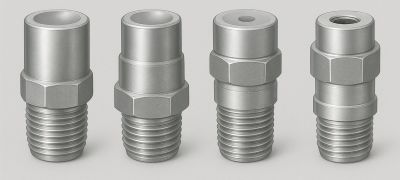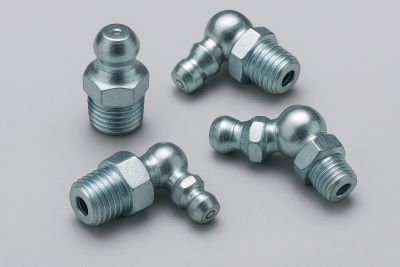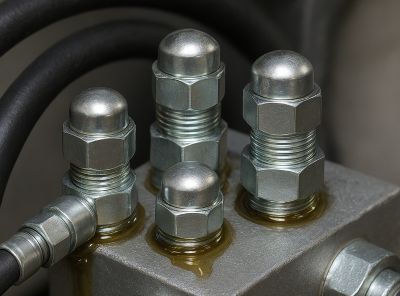Hydraulic systems are the lifeblood of modern industrial machinery. From manufacturing presses and construction equipment to aircraft controls and marine systems, these mechanisms rely on fluid power to generate precise, efficient motion. However, like any mechanical system, their reliability and performance depend heavily on proper lubrication.
Lubrication minimizes friction, reduces heat buildup, and prevents premature wear in moving parts. Without it, even the most advanced hydraulic systems would quickly deteriorate under the stress of high pressures and constant operation.
Understanding Lubrication Fittings
What Are Lubrication Fittings?
Lubrication fittings are small but essential components designed to deliver lubricants—such as grease or oil, to precise points within a mechanical or hydraulic system. They act as the interface between a grease gun (or automated lubrication system) and the part that requires lubrication.
Their primary purpose is to provide a secure, leak-proof path for lubricants to flow into bearings, joints, and other moving components.
Common Types of Lubrication Fittings
1. Grease fittings (Zerk fittings): The most common type, featuring a ball check that prevents dirt and contaminants from entering the system.
2. Button head fittings: Used for high-volume lubrication applications requiring robust connections.
3. Flush-type fittings: Ideal for equipment with limited clearance where protruding fittings could cause interference.

The Role of Lubrication in Hydraulic Systems
Hydraulic components operate under intense pressure, often exceeding thousands of PSI. Friction between moving metal surfaces generates heat and accelerates wear. Without adequate lubrication, components such as pumps, valves, and cylinders can seize or fail prematurely.
Inadequate lubrication results in:
➡️ Increased friction and energy loss
➡️ Excessive heat generation
➡️ Accelerated wear and corrosion
➡️ Reduced system efficiency and lifespan
Key Components That Require Lubrication
➡️ Pumps and Motors: Critical for maintaining consistent hydraulic flow and pressure.
➡️ Valves and Actuators: Require smooth operation to ensure accurate fluid control.
➡️ Bearings, Seals, and Linkages: Support moving parts and prevent metal-to-metal contact.
How Lubrication Fittings Work
Lubrication fittings provide a controlled entry point for lubricants. When a grease gun applies pressure, lubricant passes through the fitting’s check valve into the designated bearing or component cavity. The fitting’s design ensures that the lubricant flows evenly without leaks or contamination.
Pressure, sealing integrity, and flow control are essential for proper lubrication, too little pressure may not reach all areas, while excessive pressure can damage seals.
Installation and Maintenance
Proper installation ensures the fitting functions as intended. Key steps include:
1. Cleaning the mounting hole before installation
2. Tightening the fitting securely but not excessively
3. Using thread sealants where necessary to prevent leaks
Over-tightening, introducing contaminants during installation, and neglecting periodic inspection.
Regularly check for leaks, corrosion, or blockages and replace damaged fittings immediately.
Types of Lubrication Fittings Used in Hydraulic Systems
Standard Grease Fittings (Zerk Fittings)
Design features: Small, conical heads with a spring-loaded ball valve that allows lubricant in and prevents dirt from entering.
Applications: Widely used in hydraulic pumps, linkages, and general machinery.
Button Head Fittings
Benefits: Large head design accommodates high lubricant flow and resists disconnection under pressure.
Applications: Heavy-duty machinery, mining equipment, and construction vehicles.
Flush-Type and Bulkhead Fittings
Advantages: Flush with the surface, ideal for tight or enclosed spaces where protrusions are undesirable.
Limitations: May require special couplers for lubrication access.
Specialty and Custom Fittings
Features: Stainless steel construction, metric or inch thread variations, and unique geometries for specific systems.
Applications: Harsh environments such as marine, chemical, or food-processing industries.
Benefits of Using Quality Lubrication Fittings
1. Enhanced reliability and performance: Consistent lubrication ensures optimal system function.
2. Reduced maintenance costs: Prevents expensive repairs and downtime.
3. Extended service life: Minimizes wear and corrosion, preserving critical components.
4. Improved safety and efficiency: Well-lubricated systems operate smoothly and predictably.
Common Problems and Troubleshooting Tips
1. Leaks or Blockage: Check for damaged threads, worn seals, or hardened grease.
2. Contamination: Keep fittings clean and always use clean lubrication tools.
3. Corrosion: Use corrosion-resistant materials like stainless steel in humid or chemical-rich environments.
Always replace defective fittings promptly and ensure compatibility with system specifications.
Best Practices for Selecting Lubrication Fittings
1. System Pressure and Lubrication Type: Match fitting design to operating pressures and grease/oil viscosity.
2. Material Selection: Use brass or stainless steel in corrosive environments.
3. Accessibility and Service Frequency: Choose fittings that allow easy access for routine maintenance.
Conclusion
Lubrication fittings, though small, play an indispensable role in maintaining the health and efficiency of hydraulic systems. They ensure that vital components receive consistent lubrication, preventing wear, overheating, and premature failure.
Proper fitting selection, installation, and maintenance are key to extending equipment life and enhancing performance.
Invest in high-quality lubrication fittings today to maximize the performance, reliability, and longevity of your hydraulic equipment.
Post time: Oct-28-2025



